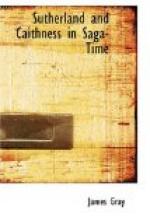We now come to the last years of the fourth period of his life, when “the earl sate down quietly and kept peace over all his realm. Then he left off warfare, and he turned his mind to ruling his people and land, and to law-giving. He sate almost always in Birsay, and let them build there Christchurch,[20] a splendid Minster. There first was set up a bishop’s seat in the Orkneys.”
The Annals of Tighernac record a great Norse expedition with the aid of the Galls of Orkney and Innse Gall and Dublin to subdue the Saxons in 1057, which failed. It is strange that we hear nothing of Thorfinn in this, and the question arises whether he had died before it took place. Had he been alive, such an expedition would hardly have been possible without him.[21] It is interesting to note that so accurate a chronicler as Sir Archibald Dunbar dates his widow Ingibjorg’s marriage to Malcolm III in 1059. (See Scottish Kings, p. 27.)
Thorfinn’s life forms the subject of no less than twenty-six chapters of the Orkneyinga Saga.[22] In his childhood, and later at all the main turning points of his life, he was blessed with the constant care and touching devotion, and with the able counsel and active assistance of his foster-father, Thorkel Fostri, the slayer of his three chief competitors—Jarl Einar and Earl Moddan and Jarl Ragnvald Brusi-son—the captain of his armies, the collector of his revenues and the guardian, in his absence on his Viking cruises and in his travels abroad, of his widespread dominions. There is a tradition[23] that Thorkel founded the rock-castle of Borve, near Farr on the north coast of Sutherland, which was demolished by the Earl of Sutherland in 1556; but Thorkel is a common name among Vikings, and the story is otherwise unauthenticated.
According to the Saga, Thorfinn died of sickness “in the latter days of Harald Hardrada,” (who was killed in September 1066), near the church which he founded, in his Hall at Birsay, north of Marwick Head in the north-west corner of Mainland of Orkney, within a few miles of the scene of Earl Kitchener’s recent death at sea, so that the greatest of our jarls and of our earls rest near each other, the great Viking on the shore, and the great soldier in the ocean.
The chronology of Thorfinn and Ingibjorg his wife is extremely difficult, but on the whole we incline to think that he was born in 1008, and, as grandson of the king regnant, was created an earl at his birth, married Ingibjorg, then quite young, in 1044, and died in 1057 or 1058, after being an earl for his whole life of “fifty years,” while his widow married Malcolm III in 1059. The phrase “in the latter days of Harald Hardrada” is after all an expression wide enough to cover the last seven years of a reign of twenty-one years, and it is unlikely that a marriage of policy would be postponed for more than the year or two after Malcolm’s accession in 1057, during which he was engaged in defeating the claims of Lulach to his throne and settling his kingdom.




